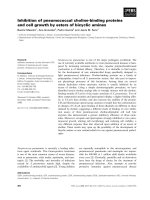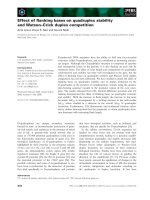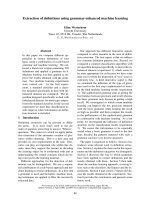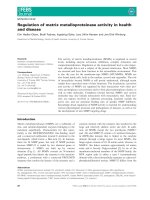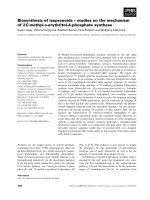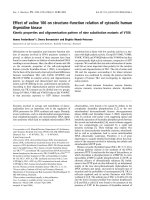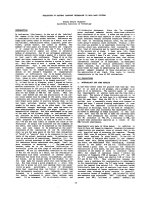Báo cáo khoa học: "Influence of browsing cessation on Picea sitchensis radial growth" pdf
Bạn đang xem bản rút gọn của tài liệu. Xem và tải ngay bản đầy đủ của tài liệu tại đây (112.27 KB, 8 trang )
Original article
Influence of browsing cessation on Picea sitchensis
radial growth
Bruno Vila*, Thierry Keller and Frédéric Guibal
Institut Méditerranéen d’Écologie et de Paléoécologie – CNRS UMR 6116, Case 451,
Faculté des Sciences et Techniques de Saint-Jérôme, 13397 Marseille Cedex 20
(Received 15 September 2000; accepted 18 January 2001)
Abstract – Picea sitchensis is an ecological and economical component of North America north temperate rain forest. In Haida Gwaii
which is one of the most productive forest land of British Columbia archipelago (Canada), it is an important and a valuable commercial
species. The present study aims at precising deer browsing consequences on growth regeneration of Picea sitchensis. Using ring-width
series, an empiricalmodel is built which describes browsing impact on radial growth and removal of these pressure. Taking into account
deer pressure and browsing upper limit when building predictive height growth models proves valuable for comparing growth pattern of
different species under browsing pressure and deducing changes in forest dynamics.
Picea sitchensis / radial growth / browsing / modeling / black-tailed deer
Résumé – Influence de l’arrêt de l’abroutissement sur la croissance radiale de Picea sitchensis. Picea sitchensis est un composant
majeur tant au niveau écologique qu’au niveau économique des forêts pluviales et tempérées del’Amérique du Nord. Sur l’archipel Hai
-
da Gwaii, qui est recouvert par une forêt des plus productive de Colombie Britannique (Canada), c’est une essence à forte valeur com
-
merciale. La présente étude vise à préciser les conséquences de l’abroutissement par le cerf à queue noire sur la croissance des individus
au cours de la régénération. Sur la base deséries d’épaisseurs de cernes, un modèle empiriquede croissance radiale est construit. Il décrit
l’effet de l’abroutissement et de la suppression de celui-ci lorsque les individus parviennent à dépasser la limite supérieure d’abroutisse
-
ment. La prise en compte de l’impact du cerf sur la croissance radiale et de la limite supérieure d’abroutissement dans l’élaboration des
modèles prédictifs de croissance en hauteur s’avère intéressante pour comparer les modèles de croissance de différentes espèces abrou
-
ties et en déduire des conséquences sur la dynamique forestière.
Picea sitchensis / croissance radiale / abroutissement / modélisation / cerf à queue noire
1. INTRODUCTION
Herbivores were introduced in the early 20th century
in several places of the world for game hunting [25]. Due
to many habitats favourable to their development and/or
due to the lack of predator, populations attained suffi
-
cient densities to exert significant impact on native vege
-
tation and animal populations [16, 34]. Haida Gwaii
archipelago is a fair example because among the eleven
Ann. For. Sci. 58 (2001) 853–859 853
© INRA, EDP Sciences, 2001
* Correspondence and reprints
Tel. +33 4 91 28 27 14; Fax. +33 4 91 28 86 68
introduced species occurs the black-tailed deer
(Odocoileus hemionus sitchensis Merriam) whose activi
-
ties became dominantsuch as disturbing ecosystem func
-
tioning [10, 14, 26].
Introduced in the North of the archipelago in 1901,
1912 and 1925, black-tailed deer were not long to settle
the whole archipelago. Single phytophagus after en
-
demic caribou (Rangifer dawsoni Seton) became extinct
in the 1920’s [6] deers make up with forest exploitation
major disturbance altering forest ecosystem dynamic.
Browsing pressure exerted by deer has radically affected
the structure and the function of understory hindering
natural regeneration and impoverishing primary or sec
-
ondary forest ecosystems [2, 10, 11, 17, 18, 19, 26, 28].
With regard to flora, deer are responsible of a severe
impoverishing of understory [3, 28] in which numerous
endemic species arelocated [23, 33].This combined with
structural site modifications is a major concern disturb
-
ing also fauna, particularly birds communities which de-
crease under introduced predators pressure [14, 17].
With regard to forest development, through browsing
exerted on seedlings and saplings, fraying scars and bark
stripping [20, 21] on older trees, deerinduce high mortal-
ity rate, delay in recruitment [9, 35], wood depreciation
and tree composition forest changes [1, 12]. Between the
three main tree species in the study area, unequal deer
browsing pressure among species results in the absence
of Thuja plicata D. Don ex Lamb. regeneration and a
sharp modification of Picea sitchensis (Bong.) Carrière
recruitment whereas Tsuga heterophylla (Raf.) Sarg.
seedlings and saplings are more often not eaten. Pojar
and Banner (1984) concluded that the severe impacts of
continued overbrowsing include the probable elimina
-
tion of Thuja plicata as commercial timber species on
Haida Gwaii and increasing damage to Picea sitchensis
and Tsuga heterophylla especially in recent plantations.
Changes concerning wood industry are quite noticeable
and will become important in the future. So far, their
main consequences are a deliberate decrease of annual
timber volume in order to compensate the longer time
necessary for re-establishmentfrom expensiveplantation
with protected saplings [15].
The richness displayed by insular ecosystems such as
those of Haida Gwaii is huge in terms of flora endemism,
birds communities and timber quality produced; there
-
fore understory browsing by deer induces far-reaching
effects on biodiversity [23, 33], landscape and economy
[24]. A five-year pluridisciplinary project “Forest ecol
-
ogy, forest renewal and introduced species in Haida
Gwaii, Queen Charlotte Islands” carried out by the Re
-
search Group on Introduced Species aims at understand
-
ing the biological effects of species introduced in the for
-
ests of Haida Gwaii. This project focuses on the
interactions between vegetation, introduced animals and
it also investigates changes in the biodiversity and ecol
-
ogy of protected and harvested forests.
Because Picea sitchensis is anoutstanding timber spe
-
cies in coastal British Columbia especially in Haida
Gwaii archipelago where it covers 21% of the timber har
-
vesting landbase [5], the present study aims at precising
deer browsing consequences on growth regeneration of
Picea sitchensis. Using ring-width series in order to evi
-
dence particular growth patterns, we aim at building an
empirical model that describes impacts of browsing and
cessation of browsing pressure on young tree growth.
Taking into account deer pressure and browsing upper
limit when building predictive height growth models
proves valuable for comparing growth pattern of differ
-
ent species under browsing pressure and deducing
changes in forest dynamics.
2. MATERIALS AND METHODS
2.1. Area characteristics
The Haida Gwaii archipelago (53° N, 132° W) situ-
ated on the Pacific coast (British Columbia, Canada) is
composed of more than 150 islands (figure 1). Sampling
was focused on Laskeek Bay islands, located in the east
-
ern side of the archipelago which corresponds to the
Coastal Western Hemlock Zone, wet Hypermaritime
sub-zone [4]. At low elevation, old-growth forests con
-
sist of a mixture of Tsuga heterophylla the dominant spe
-
cies, Thuja plicata often codominant and Picea
sitchensis of which regeneration depends on windthrow.
The understory is composed of shrubs as Gaultheria
shallon Pursh, Vaccinium parvifolium Smith in Rees,
grasses, mosses and lichens [3].
2.2. Deer in British Columbia
On coastal British Columbia, black-tailed deer inhab
-
its a variety of serial stages from recent clear-cut areas to
old-growth forests. Type of habitat used depends largely
on season and climate. Browsed species andtheir propor
-
tion evolve according to seasons and deer frequentation
of sites [13]. Old-growth Western hemlock-Sitka spruce
forests provide important habitat for black-tailed deer
854 B. Vila et al.
whereas even-aged second-growth forests produce
enough forage for the deer only during the 30 years fol-
lowing the felling [37] due to the canopy closure. On
small islands (less than 300 ha) where the study is carried
out and which are totally covered by primary forest, deer
preferentially uses coastal range and windthrows. Those
areas are privileged foraging sites because deer can find
there an abundant and pioneer vegetation with better nu
-
tritive values than understory species [32]. In that areas,
plant availability for deer foraging is low and mostly
represented by Gaultheria shallon and Vaccinium
parvifolium in shoreline, regeneration of Picea sitchensis
and grass in windthrow.
2.3. Picea sitchensis
Picea sitchensis is a major componentof North Amer
-
ica north temperate coastal rain forest. Large, commonly
to 70 m tall, it grows in pure or mixed stands often on
moist well drained sites such as alluvial floodplains, ma
-
rine terraces, headlandsand old logs [27].It is a shade-in
-
tolerant, submontane to montane evergreen conifer
occurring in hypermaritime tomaritime mesothermal cli
-
mates on nitrogen-rich soils. Its occurrence increases
with increasing latitude and precipitation and decreases
with increasing elevation and continentality. It forms
pure open-canopy stands along the outer-coast on sites
affected by ocean spray and in advanced stages of pri
-
mary succession on floodplains. Picea sitchensis is usu
-
ally associated with Tsuga heterophylla or Thuja plicata
in stands that have some of the highest growth rates in
North America [24].
Picea sitchensis is a valuable commercial species. On
Haida Gwaii, a mild climate, high rainfall, lack of sum
-
mer drought and few diseases combine to give this archi
-
pelago some of Canada mostproductive forest lands.The
Haida Gwaii land base contributed over 3% of British
Columbia annualtimber harvest, withSitka spruce asone
component of this harvest [24].
2.4. Sampling
Sampling is focused on individuals directly affected
by disturbance [34]. Browsing induces on severely
browsedspruces a shrubby port under thebrowsing limit;
once saplings have overcome the browsing limit they dis
-
Browsing cessation and radial growth 855
Figure 1. Haida Gwaii archipelago and
Laskeek Bay islands.
play a regular port above it (figure 2). Escaped individu-
als were collectedin two windthrows of thecoastal conif-
erous forest, on ecologically homogeneous and
comparable islands. Afirst windthrow is locatedat Lime-
stone Island (49 ha)and a second is located at ReefIsland
(249 ha). Both islands are characterized by a density of
0.30 deer/ha. No shrub layer, no ground vegetation,
browsing limit occurring at 1.10 m and palatable species
confined to inaccessible areas indicate a very heavy pres-
sure according to the table completed by Reimoser et al.
(1999). Sampling consisted in collecting at the bottom of
each tree cores by means of aSwedish increment borer or
stem cross sections taken when it was not possible tocore
them due to their small diameter. Coring was repeated
until pith was reached foreach tree. 37 spruces weresam
-
pled at Limestone Island; 4 spruces were sampledat Reef
Island.
2.5. Method
Once cores or sections were sanded, two radii were
measured (1/100 mm) along a radial file of cells using
Eklund measuring device and ring-width series were
crossdated. The average value of each ring was calcu
-
lated in order to obtain a mean chronology for each tree
according to dendrochronology methods [30, 31]. The
particular radial growth pattern due to browsing evi
-
denced in a previous study [36] was observed. This pat
-
tern is characterized by narrow ring widths followed by a
sharp positive growth change occurring when herbivore
pressure stops (figure 3). Then each tree curve was syn
-
chronized with others according to its abrupt growth
change. Standardizing of individuals ring-width series
consisted in dividing each by its standard deviation.
Then, median, 5th and 95th percentiles were calculated
from those indexed ring series. Modelling of median, 5th
and 95th percentiles was carried out by means of least
squares method using sigmoid function identified on in
-
dividuals radial growth curves.
50 03
22
1
12 4
th percentile=+
+
+
.
.
(– . )
e
x
856 B. Vila et al.
Figure 2. Architecture of still severly browsed spruces (below
browsing limit) and of escaped spruces.
0
100
200
300
400
500
600
700
800
1975 1980 1985 1990 1995
Years
0
100
200
300
400
500
600
700
0 5 10 15 20 25 30
Relative years
Ring width (1/100 mm)
Ring width (1/100 mm)
Figure 3. Above. Individuals ring-width curves synchronised
according to years. Below. Individuals ring-width curves syn
-
chronised according to their abrupt growth change.
3. RESULTS
Ring width variations and differences between 5th
and 95th percentiles are very low during the browsing
period indicating that browsing exerts a severe impact
(figure 4). Annual radial growth varies from a mean in
-
dex equal to 0.14 during the browsing period to 1.0 when
browsing stops: growth is multiplied per 7 within only
5 years. During browsing period, mean ring width is
equal to 0.49 mm (σ = 0.06); then, it reaches 3.55 mm
(σ= 0.50) when browsing ceases (Mann-Whitney test,
t = 20.76; p ≤ 0.001). Afterwards growth stays stable and
common annual ring-widths variations are higher than
during the browsing period which seems to evidence a
higher sensitivity to interannual climate variations. Coef
-
ficients of determination are equal to 0.99 (median), 0.78
(5th percentile) and 0.95 (95th percentile).
4. DISCUSSION
Picea sitchensis is not heavily browsed when alterna
-
tive food sources are available. Usually Thuja plicata is
the preferred species for deers but even when itis present,
little browsing occurs on Picea sitchensis. Coates et al.
(1985) studied the effectof deer browsing in HaidaGwaii
and found few browsing losses on Picea sitchensis or
Tsuga heterophylla but heavily losses on Thuja plicata.
But given that Thuja plicata is gradually eliminated by
deer browsing, damages to Picea sitchensis and Tsuga
heterophylla regeneration are expected to increase. As a
result, systems of forest management involving small
clear-cuts, shelterwood or selection will probably be
ruled out by the intense browsing that occurs in all coni
-
fer regeneration in small cleared areas of Haida Gwaii
forests [26]. Presently, due to growth delay in regenerat
-
ing harvested areas, an annual allowable timbering re
-
duction is being made in management acts (Tree Farm
Licence 24) to overcome losses due to browsing [7]. For
example, Vila et al. [35] showed that spruce saplings
which are being browsed usually take more than 13 years
to reach 1.10 m high, the browsing height above which
growth gets undisturbed, while this height is attained
within only 5 years for deer-protected saplings [9].
Therefore browsing pressure exerted by deer delays sap
-
lings recruitment up to 8 years when deer density is 0.30
deer/ha.
Height-age models are used in forestry to assess
height from age and site-index. Height reflects the poten
-
tial production of a site. A curve is generated by the
Browsing cessation and radial growth 857
0.00
0.25
0.50
0.75
1.00
1.25
1.50
1.75
2.00
-15 -10 -5 0 5 10 15
Relative years
Med Med-mod
0.050 5%-mod
0.950 95%-mod
Growth index
Figure 4. Radial growth model including browsing stage and escaped stage.
model for each site index [22] but problems occur as far
as age is concerned. Either one considers age from the
bottom or from a given height on the trunk. In the present
study,breast height age (1.30 m)is more appropriate than
age at the bottom because height growth below breast is
largely disturbed by browsing. On Haida Gwaii where
browsing limit occurs at 1.10 m high [36], breast height
seems convenient but for areas under other ungulates
browsing pressure, this level could be too low [7]. Gen
-
erally, age determined at a given height should be pre
-
ferred because underneath it is often influenced by
competition with understory or other non-site factors [8].
Age allowance should not be neglected as a single small
age error could lead to larger error in fertility index. In
addition, the smaller the age and the higher the fertility,
the higher the error.
Ring-widths analysis can provide information on the
trees capacity (i) to stand browsing and on its temporal
variationand (ii) to escapedeer teeth. Inthe present study
Picea sitchensis capability to survive and grow at a high
rate, once escaped, reveals some resistance to browsing
that does not occur in all tree species [7]. For instance,
Thuya plicata is less resistant either because its seedlings
are heavily browsed or because a much larger amount of
foliage is browsed than for spruce; a large reduction of
foliage induces a high mortality rate. As far as spruce is
concerned, damages occur on young shootsduring spring
flush after winter consumption of other ligneous plants
by deer [26]. Browsing results in ablation of young
shoots of which only basal needles remain; previous
years shoots are not browsed because thorny ligneous
needles cause a physical defense.
5. CONCLUSION
Deer impact on ring series is characterized by a high
growth reduction (8-year delay between impacted and
non impacted saplings) and by very narrow rings which
are followed by a positive growth change when herbivore
pressure stops [36]. Present on all trees, browsed in the
past and now escaped, this pattern can be modeled show
-
ing the homogeneity of tree response facing the distur
-
bance. In next studies carried out by the Research Group
on Introduced Species, two other browsed species (Thuja
plicata and Tsuga heterophylla) will be analyzed in the
same way in order to determine their growth pattern un
-
der browsing pressure to understand variations in regen
-
eration dynamicssusceptible to modifytimber economy.
So far, growth of browsed saplings had never been
modeled meanwhile it appears necessary to take into
account accurately height growth only above the brows
-
ing limit otherwise the height-age model does not reflect
growth potential supplied by the habitat but browsing
pressure exerted at the site.
Developing such an investigation is not only funda
-
mental in describing adequately growth patterns and
therefore comparing specific responses to browsing and
understanding interactions dynamic but also in setting
forward predictive approaches of a sustainable manage
-
ment of temperate forests submitted to increasing brows
-
ing by wild ungulates.
Acknowledgments: The pluridisciplinary project is
funded by the Forest Renewal British Columbia (FRBC),
South Moresby Forest Replacement Account (SMFRA),
International Program for Scientific Cooperation (PICS
489, France – Canada). Significant funding and logistic
support are also provided by the Archipelago Manage
-
ment Board (Parks Canada), Laskeek Bay Conservation
Society, Canadian Wildlife Service, Ministry of Forests
and the CNRS in France.
REFERENCES
[1] Anderson R.C., Loucks O.L., White-tail deer (Odocoileus
virginianus) influence on structure and composition ofTsuga ca-
nadiensis forests, J. App. Ecol. 16 (1979) 855–861.
[2] Baltzinger C., Impact d’un grand herbivore sur la dyna
-
mique derégénération deThuja plicata après perturbation sur les
îles de la Reine Charlotte (Canada). Mémoire de D.E.A., Centre
d’Écologie Fonctionnelle et Évolutive, CNRS, Montpellier,
1997, 30 p.
[3] Banner A., Pojar J., Schawb J. W., Trowbridge R., Vege
-
tation and soils of the Queen Charlotte Islands: recent impacts of
development, in: Scudder G.G.E., Gessler N. (Eds.), The Outer
Shores. Based on the Proceedings of the Queen Charlotte Islands
First International Symposium, University of British Columbia,
1989, pp. 261–279.
[4] Banner A., Green R.N., Inselberg A., Klinka K., McLen
-
nan D.S., Meidinger D.V., Nuszdorfer N.S., Pojar J., Site classi
-
fication for the coastal British Columbia, Min. For., Victoria,
BC, Pamphlet, 1990.
[5] British Columbia Ministry of Forests, Queen Charlotte
TSA timbersupply analysis,B.C., Min. For., Victoria, BC,1994.
[6] Carl G.C., Guiguet C.J., Alien animals in British Colum
-
bia. Brit. Col. Prov. Mus. Handb. 14, Victoria, BC, 1972.
[7] CEMAGREF, Dégâts de gibier, identification, méthodes
de protection. Note technique n° 44, 1981, 64 p.
[8] CEMAGREF, Groupe de travail sur la typologie des sta
-
tions forestières, Station forestière, production et qualité des
858 B. Vila et al.
bois : éléments méthodologiques, Ouvrage réalisé avec le
concours du Ministère de l’Agriculture et de la Forêt, Coordina
-
tion CEMAGREF, 1989, 254 p.
[9] Coates K.D., Pollack J.C., Barker J.E., The effect of deer
browsing onthe early growth of tree conifer species in theQueen
Charlotte Islands. B. C. Min. For. Research Report RR85002-
PR, 1985, 13p.
[10] Daufresne T., Modification de la dynamique et de la di
-
versité dela végétation par un grand herbivore. Impact de l’intro
-
duction du cerf-à-queue-noire dans la forêt primaire des îles
Haida Gwaii (Colombie Britannique, Canada). Mémoire de
D.E.A., Centre d’Écologie Fonctionnelle et Évolutive, CNRS,
Montpellier, 1996, 38 p.
[11] Foster J.B., Conservation on the Queen Charlotte
Islands, in: Scudder G.G.E., GesslerN. (Eds.), The Outer Shores.
Based on the Proceedings of the Queen Charlotte Islands First
International Symposium, University of British Columbia, 1989,
pp 281–301.
[12] Frelich L.E., Lorimer.C.G., Current and predicted long-
term effects of deer browsing in Hemlock forests in Michigan,
USA, Biol. Conserv. 34 (1985) 99–120.
[13] Harestad S., Habitat use by black-tailed deer on northern
Vancouver Island, J. Wildl. Manag. 49 (1985) 946–950.
[14] Hartman L.H., Gaston A.J., Eastman D.S., Raccoon pre-
dation onancient murreletson eastLimestone Island,British Co-
lumbia, J. Wildl. Manag. 61 (1997) 377–388.
[15] Henson B., The impact of introduced Sitka black-tailed
deer on the Queen Charlotte Islands, For. 348 Lect. Not., 1980,
26 p.
[16] Mark A. F., Baylis G.T.S., Dickinson K.J.M., 1991. Mo-
nitoring the impacts of deer on vegetation condition of Secretary
Island, Fiordland National Park, New Zealand: a clear case for
deer control and ecological restoration, J. Royal Soc. N. Z. 21
(1991) 43–54.
[17] Martin J.L., The impact of red squirrel and black-tailed
deer on forest birds andvegetation inLaskeek Bay: aprogress re
-
port. Laskeek Bay Conservation Society, Queen Charlotte City,
BC, Annual Scientific Report No. 5, 1994.
[18] Martin J.L., Daufresne T., Introduced species and their im
-
pact on the forest ecosystem of Haida Gwaii, in: Wiggins G. (Ed.),
Proceedings of the cedar symposium, Canada, B.C. South Moresby
Forest Replacement Account. Victoria, 1999, pp. 69–89.
[19] Martin J.L., Brown J., Widmer-Carson L., Harfenist A.,
Heise K., Mercier S., The impact of introduced mammals on the
vegetation and land of old-growth forest in Haida Gwaii (Queen
Charlotte Islands): preliminary results. Laskeek Bay Conserva
-
tion Society, Queen Charlotte City, BC, Annual Scientific Re
-
port No. 4, 1993.
[20] Motta R., Dendroecology in ungulate forest damages.
1. Fraying scars, Dendrochron. 13 (1995) 33–41.
[21] Motta R., Dendroecology in ungulate forest damages.
2. Bark striping scars, Dendrochron. 15 (1997) 11–22.
[22] Nigh G.D., A Sitka spruce height-age model with impro
-
ved extrapolation properties,For. Chronicle 73 (1997) 363–369.
[23] Ogilvie R.T., Disjunct vascular flora of Northwest Van
-
couver Island in relation to Queen Charlotte Islands’ endemism
and Pacificcoastal refugia,in: Scudder G.G.E, Gessler N. (Eds.),
The Outer Shores. Based on the Proceedings of the Queen Char
-
lotte Islands First International Symposium, University of Bri
-
tish Columbia, 1989, pp 127–130.
[24] Peterson E.B., Peterson N.M., Weetman G.F., Martin
P.J., Ecology and management of Sitka spruce, Emphasizing its
natural rangein British Columbia, UBC Press, Vancouver, 1997,
336 p.
[25] Petrides G.A., The importation of wild ungulates into
Latin America with remarks on their environmental effects,
Environ. Conserv. 2 (1975) 47–51.
[26] Pojar J., Banner A., Old-growth forests and introduced
black-tailed deer on the Queen Charlotte Islands, British Colum
-
bia. Meehan, William R., Theodore R., Merell Jr, Thomas A.,
Hanley (Eds.),Fish an Wildlife Relationships in Old-Growth Fo
-
rests: Proceedings of a symposium held in Juneau, Alaska, 1984.
Amer. Inst. Fish. Res. Biol.
[27] PojarJ., MacKinnon A., Plants of coastal British Colum
-
bia. Ministry of Forests and Lone Pine Publishing, Vancouver,
BC, 1994.
[28] Pojar J., Lewis T., Roemer H., Wildford D.J., Rela-
thionships between introduced black-tailed deer and the plant
life of the Queen Charlotte Islands, British Columbia. Unpubl.
Rep. Brit. Col. Min. For. Smithers, 1980.
[29] Reimoser F., Armstrong H., Suchant R., Measuring fo-
rest damage of ungulates: what should be considered, For. Ecol.
Manag., 120 (1999) 47–58.
[29] Schweingruber F.H., Tree-rings, Basics and applications
of dendrochronology, D.Reidel Publ. Company,Dordrecht, 1988.
[30] Schweingruber F.H., Tree Rings and Environment. Den
-
droecology. Birmensdorf, Swiss Federal Institute for Forest,
Snow and Landscape Research, Paul Haupt, Berne, Stuttgart,
1996.
[31] Shimoda K., Kimura K.,Kanzaki M.,Yoda K. 1994. The
regeneration of pioneer tree species under browsing pressure of
Sitka deer in an evergreen oak, For. Ecol. Res. 9 (1994) 85–92.
[32] Taylor R.L., Vascular plants of the Queen Charlotte
Islands, in: Scudder G.G.E., GesslerN. (Eds.), The Outer Shores.
Based on the Proceedings of the Queen Charlotte Islands First
International Symposium, University of British Columbia, 1989,
pp. 121–126.
[33] Tessier L., Guibal F., Schweingruber F.H., Research
strategies in dendroecology and dendroclimatology in mountain
environments, Climatic Change 36 (1997) 499–517.
[34] Veblen T.T., Mermoz M., Martin C., Ramilo E., Effects
of exotic deer on forest regeneration and composition in Nor
-
thern Patagonia, J. Appl. Ecol. 26 (1989) 711–724.
[35] Vila, B., Guibal F., Browsing influence in the understory
of Haida Gwaii (British Columbia, Canada) forests using den
-
drochronology, Dendrochron., in press.
[36] Wallmo O.C., Schoen J.W., Response of deer to secon
-
dary forest succession in Southeast Alaska, For. Sci. 26 (1980)
448–462.
Browsing cessation and radial growth 859
